An overlooked masterpiece re-discovered

The overlooked masterpiece warning of a Cold War apocalypse
(Image credit: Fondation Oskar Kokoschka DACS 2021/ The Courtauld)
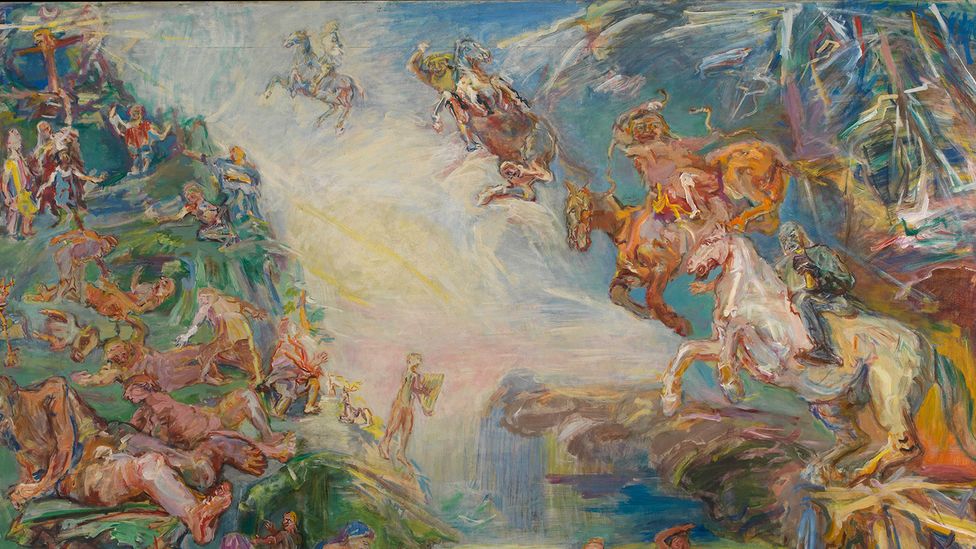
The artist Oskar Kokoschka reworked ancient myths to express his fears for humanity. Daisy Dunn explores the meaning of the remarkable Prometheus Triptych – and how it resonates today.
O
Oskar Kokoschka was not only a beautiful-sounding name, but a household name, at least until the mid-20th Century. Born in Pöchlarn, near Vienna, in 1886, he achieved fame as an Expressionist painter, printmaker and playwright, with a sharp eye for dark and unsettling stories. Once as well-known as Gustav Klimt and Egon Schiele, whom he worked alongside in his younger years, Kokoschka has since fallen into relative obscurity – at least until now.
More like this:
– Why magic’s secret symbols fascinate us
– Exposing the evil in the ordinary
– Paintings of ‘rage, rebellion and pain’
This month, the re-opening of the Courtauld Gallery in London after a major three-year restoration sees one of the largest and most extraordinary of Kokoschka’s works go back on display following an even longer hiatus. The Prometheus Saga or Prometheus Triptych consists of three canvases spanning more than eight metres in total filled with colourful but terrifying scenes of the apocalypse and eternal punishment, inspired by Biblical passages and Greek myth. Confined to storage for more than a decade, the paintings have now been given pride of place in the newly refurbished 20th-Century gallery within the building.
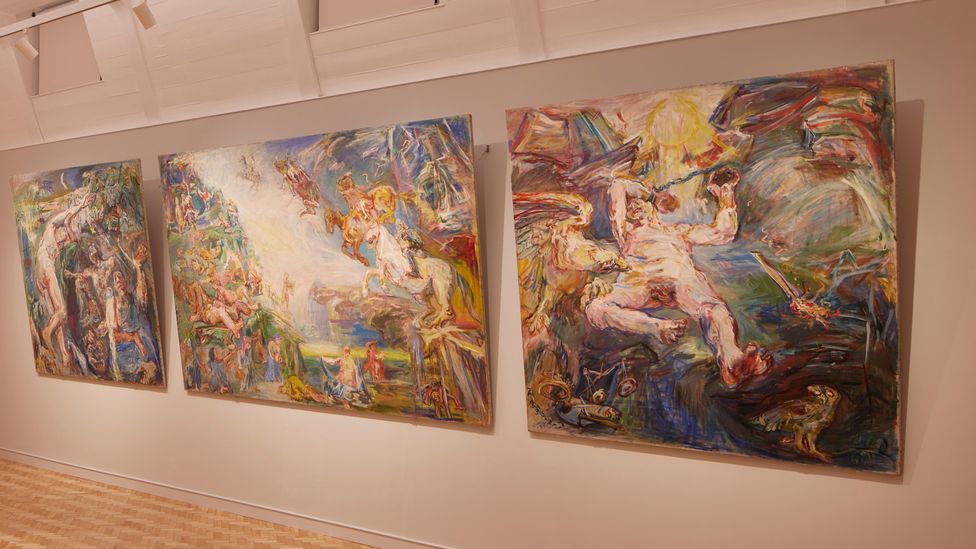
The Prometheus Triptych is on display at the newly refurbished Courtauld Gallery in London (Credit: Courtauld)
Named after the industrialist and collector Samuel Courtauld, whose artworks formed the basis of the collection, the Courtauld Gallery is most renowned for its Impressionist and Post-Impressionist paintings – including those of Monet, Manet, Cézanne and Renoir – as well as its artworks by Rubens and earlier medieval and Renaissance works. Following the gallery refit, however, many less familiar works, especially those dating to the 20th Century, are being given a new lease of life. Kokoschka’s are some of the most arresting among them.
The largest of Kokoschka’s three panels originally hung on the ceiling of a London townhouse. An Anglo-Austrian count and art collector named Antoine Seilern commissioned the triptych in 1950, and is thought to have hung the other two canvases on the walls beneath. As startling as it must have been to stroll into Seilern’s hall on Princes Gate, Knightsbridge, and gaze up at the apocalypse unravelling above, the three paintings are really intended to be viewed together on the same plane. “Considerations of conservation mean we can’t put the paintings on the ceiling, but we are hanging them high on the walls and tilted forward at a dramatic angle, so it’s very immersive,” says Dr Barnaby Wright, deputy head of the Courtauld Gallery. “We removed them from their frames so there is less distance between the canvases. They are designed to be seen in continuum.”
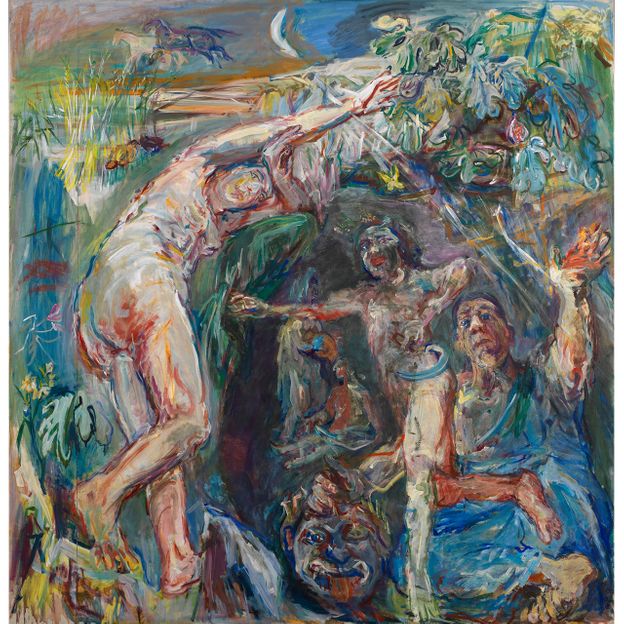
Mythical figures Hades and Persephone are depicted in the left-side canvas of Kokoscha’s powerful 1950 triptych (Credit: Fondation Oskar Kokoschka DACS 2021/ The Courtauld)
Kokoschka wrote of introducing to the triptych “a fourth dimension of movement”, so that viewers could follow the story he was painting. His left-side canvas shows Hades, god of the Underworld, releasing Persephone, the young girl he abducted and tricked into eating some pomegranate seeds so that she would have to remain with him for part of each year. Kokoschka spookily painted his own portrait on to Hades’ body, while the scarier face of the Gorgon Medusa peeps out from the bottom of the painting. Persephone’s mother, Demeter, is shown forming an arch for Persephone to pass under into the upper world to welcome in spring. However it will not be long before the seasons change and Persephone is forced to return to the shadowy lair of the dead.
In the middle canvas, horsemen of the Apocalypse descend from a lightning-struck sky upon an exquisite sunny hillside of people going about their lives. One woman is playing music. Another is bathing. Several are collecting water. The horsemen catch them unawares, the mortals at the top of the hill standing before a crucifix in shock, arms outspread or hands met in prayer, while death arrives to shake them from their slumber. We are left in little doubt that the still serenity of the middle sky and waterfall lying between them is about to be crushed.
Apocalyptic vision
Finally, the canvas on the right depicts Prometheus, the titan who stole fire from the gods, and gave it to men so that they could fend for themselves, for which he was punished by being tied to a rock on the Caucasus and having his liver pecked by Zeus’ eagle. The organ always grew back to be pecked at some more. According to one ancient source he endured this ordeal for 30,000 years.
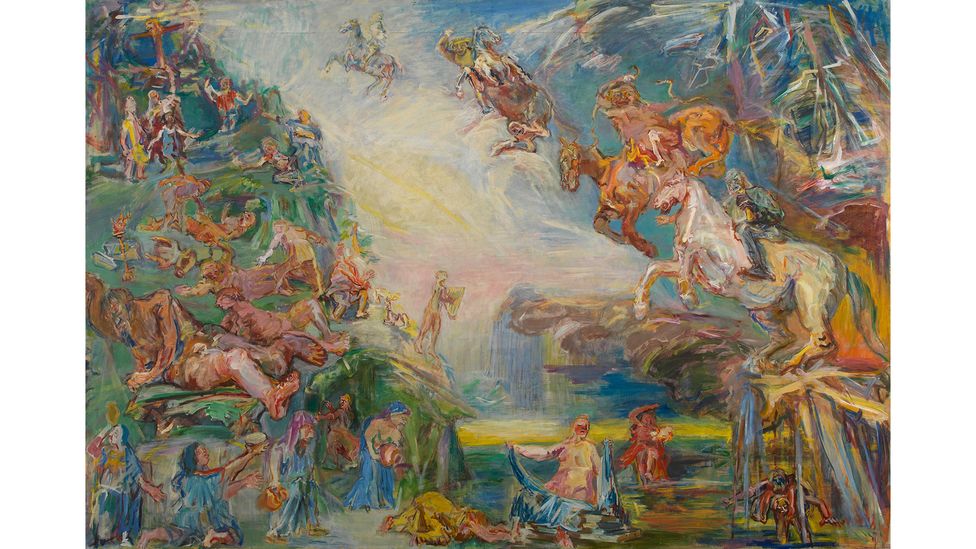
A terrifying scene is portrayed in the central painting, as the horsemen of the Apocalypse descend on humanity (Credit: Fondation Oskar Kokoschka DACS 2021/ The Courtauld)
In antiquity, Prometheus had sometimes been presented as a champion of mankind, whose quest to steal fire was driven by a desire to make them self-sufficient. But a Greek farmer-poet named Hesiod, who lived in the seventh Century BC, around the time Homer’s epics were completed, characterised Prometheus as a mischievous figure, who attempted to trick Zeus by apportioning him bones wrapped in fat, while he kept the meat for himself. Kokoschka, who loved Greek literature and collected antique coins, viewed Prometheus entirely negatively as a symbol of intellectual arrogance. Prometheus was the pivotal figure in his triptych because he represented everything that Kokoschka believed was wrong with the world in his day. The thief’s miserable punishment highlighted for him the dangers of an “overweening nature” and of the hubristic desire to overstep the natural boundaries of humanity and challenge the gods.
Prometheus spoke to Kokoschka particularly of the dangers mankind was bringing upon itself in the wake of World War Two by developing ever more sophisticated weapons. The nuclear threat of the Cold War made real the prospect of an apocalypse. After Prometheus was chained to the rock, the Golden Age – in which humans were said to have lived in regular communication with the gods, and have everything they needed without having to work for it – was over. The harsh realities of poverty, sickness and toil subsequently became man’s lot. The gods were no longer at the sides of mortals. Kokoschka may have noticed that the coming of “evil”, of which ancient poets spoke, was kakos in Greek, and thus not far from his own name. In casting himself as Hades in the painting, he acknowledged that it was in his hands to keep hope down, but also to put it out into the world. Persephone was free to go whereas Prometheus was not.
As an artist, Kokoschka felt a moral responsibility to issue a warning through these paintings not to get tied up in matters over which we are unable to maintain full control. Anxieties of the Cold War era compelled him to caution against playing with fire. Experience had taught him that more than one rebel’s fingers would be burned. Kokoschka had himself sustained severe head and lung injuries while fighting on the Eastern Front in World War One. Decades on, in the aftermath of World War Two, he recognised that the future of the world was still uncertain, and the cultural landscape under threat of being bulldozed by dangerous ideologies.
He wrote in an essay about his triptych of the need he felt to strengthen ties to the past “lest we reach the point at which every individual in his intellectual arrogance makes it his business to push the engines of destruction to the limit…” He aimed his Prometheus Saga at young people, in particular, in the hope that they would heed its lessons and safeguard “Europe’s spiritual heritage”. It was partly towards this aim that he utilised classical myth and adopted such a traditional format. Triptychs were historically employed for altarpieces in churches. Kokoschka considered it essential that people looked backwards as well as forwards in order to avoid being carried away by the often overblown and sometimes sinister promises of new technology. His existential fears were inherent to Viennese Expressionism, which developed around 1910, but also to the Cold War period.
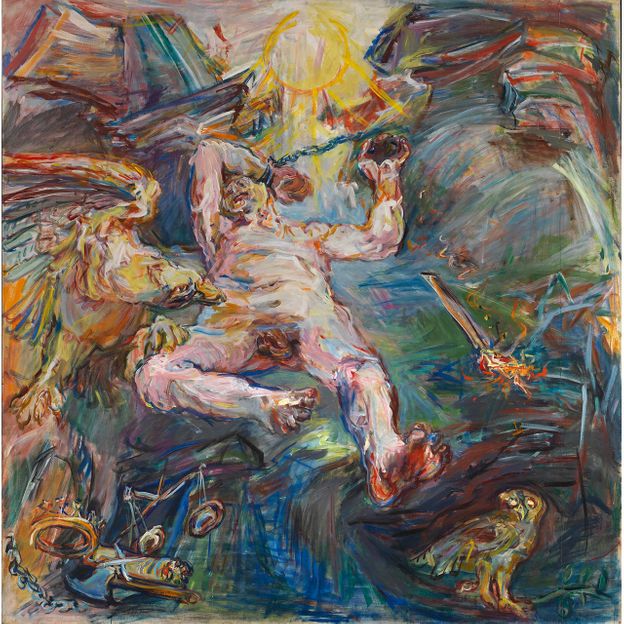
The right-hand canvas shows a nightmarish scene as Prometheus is punished (Credit: Fondation Oskar Kokoschka DACS 2021/ The Courtauld)
Both Klimt and Schiele lost their lives during the Spanish Flu epidemic which swept through Europe at the end of the World War One. Although Kokoschka escaped, he carried his war wounds with him around Europe through the 1920s, until financial troubles forced him to return to Vienna in 1931. He then moved to Prague and fell in love with his future wife, Olga, before finding himself classified a “degenerate” artist under the Nazi regime, and fleeing to England. He had suffered enough uncertainty in his own life to embrace the opportunity Count Seilern gave him to commit his manifesto for the future to three canvases saturated in warnings – and the faint prospect of hope – from the ancient past. As Dr Barnaby Wright says: “Removing the frames makes it seem like the canvases were painted yesterday. Kokoschka really does speak to a contemporary way of working”. In theme, too, his paintings could hardly appear more urgent. Their full weight will hover over viewers as they walk through the gallery this month.
Oskar Kokoschka’s Prometheus Triptych is on display at the Katja and Nicolai Tangen 20th Century Gallery at the Courtauld, London, which reopens on 19 November.
Daisy Dunn is the author of Of Gods and Men: 100 Stories from Ancient Greece and Rome.
If you would like to comment on this story or anything else you have seen on BBC Culture, head over to our Facebook page or message us on Twitter.
And if you liked this story, sign up for the weekly bbc.com features newsletter, called The Essential List. A handpicked selection of stories from BBC Future, Culture, Worklife and Travel, delivered to your inbox every Friday.








